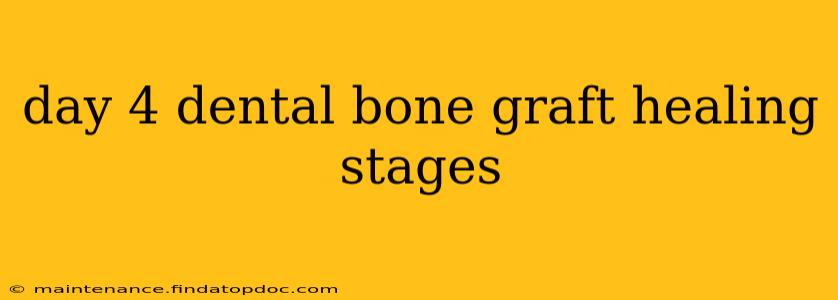Undergoing a dental bone graft is a significant procedure, and understanding the healing process is crucial for managing expectations and ensuring a successful outcome. While every individual heals differently, this post will outline the general healing stages you can expect around day 4 post-surgery, addressing common questions and concerns. We will explore what to anticipate, potential complications, and how to best care for your mouth during this early phase of recovery.
Understanding the Initial Healing Phase:
The first few days after a dental bone graft are the most critical. The focus is on minimizing inflammation, preventing infection, and promoting initial clot formation. Day 4 falls squarely within this initial, acute healing phase. You'll likely still experience some discomfort, swelling, and bruising. The healing process isn't immediately visible, but important cellular processes are already underway.
What Happens on Day 4 After a Bone Graft?
On day 4, the healing process is still in its early stages. Expect:
- Continued Swelling: Swelling is usually at its peak around 2-3 days post-surgery, but you'll still notice considerable swelling on day 4. It may be slightly reduced from its peak but will likely persist for several more days.
- Bruising: Bruising is common, particularly in the area surrounding the graft site. The color might change from deep purple to greenish-yellow as the healing progresses.
- Discomfort: You'll probably still experience some discomfort, although pain medication should help manage it. The level of discomfort varies greatly among individuals.
- Limited Mouth Opening: You may find it difficult to open your mouth wide. This is due to swelling and the healing process.
- Blood-tinged Saliva: Some blood-tinged saliva is normal during the initial days. However, excessive bleeding should be addressed by contacting your dentist.
What Should I Expect Regarding Pain?
Pain management is a critical aspect of the post-operative period. On day 4, your initial pain might be lessening, but you might still need pain medication prescribed by your dentist. Always follow their instructions carefully regarding medication dosage and frequency.
Is it Normal to Still Have Swelling on Day 4?
Yes, swelling is entirely normal on day 4 after a dental bone graft. The body's natural inflammatory response is working to heal the surgical site. The swelling should gradually decrease over the next few days and weeks. Applying ice packs can help reduce swelling and discomfort.
What are the Signs of Infection After a Bone Graft?
While less common with proper post-operative care, infection is a serious concern. Watch for these signs, and contact your dentist or oral surgeon immediately if you notice any:
- Increased pain and swelling: A sudden spike in pain or swelling that doesn't improve with medication is a red flag.
- Redness and heat around the surgical site: This indicates potential inflammation beyond normal healing.
- Pus or foul-smelling discharge: This is a definitive sign of infection.
- Fever or chills: These systemic symptoms point to a possible infection.
How Long Does It Take for a Bone Graft to Fully Heal?
Complete healing from a dental bone graft takes several months, even up to a year. The initial few weeks are crucial, as the body focuses on creating a stable blood clot and starting the bone regeneration process. Day 4 is just the beginning of a much longer journey. Regular follow-up appointments with your dentist are vital to monitor progress and address any potential complications.
What Can I Do to Promote Healing?
Following your dentist's instructions meticulously is paramount. This typically includes:
- Gentle rinsing: Use a prescribed antiseptic mouthwash to keep the area clean.
- Soft food diet: Avoid hard, crunchy, or chewy foods that could dislodge the graft.
- Regular medication: Take prescribed pain relievers and antibiotics as directed.
- Avoid smoking and alcohol: These habits significantly hinder healing.
- Ice packs: Apply ice packs to reduce swelling and inflammation.
Remember, the information provided here is for general guidance only and should not replace the advice of your dentist or oral surgeon. Always follow their specific instructions for post-operative care, and contact them immediately if you have any concerns. Your individual healing journey may vary, but understanding these general stages can help you navigate the process with greater confidence.
